Assembling of Carbon Fibre/PEEK Composites: Comparison of Ultrasonic, Induction, and Transmission Laser Welding
Abstract
1. Introduction
2. Materials and Methods
2.1. Materials and Samples Preparation
- Thermoplastic composite prepregs carbon fibre HM63/PEEK developed by Suprem (Yverdon-les-Bains, Switzerland) and supplied by Centre National d’Etudes Spatiales (CNES, Toulouse, France) as 140 µm thick tapes. The latter, named CF/PEEK in the following, was made of PEEK 150G from Victrex as a matrix and unsized carbon fibre HM63 from Hexcel. HexTow HM63 carbon fibre is a continuous, high strength of 4.5 GPa and high modulus of 452 GPa, with a density of 1.83 g·cm−3, polyacrylonitrile-based carbon fibre.
- PEEK 450 G from Victrex (Lancashire, UK) in granules for DMTA and TGA only.
- PEI Ultem 1000 from Sabic (Rijad, Saudi Arabia) in granules.
- PEI Ultem 1000 as 250 µm thick film was purchased from GoodFellow (Lille, France).
2.2. Characterization of Materials
- (1)
- roughness and surface chemistry,
- (2)
- rheological, optical, and thermal properties.
2.2.1. Drying of Specimens
- (1)
- drying at 150 °C for at least 3 h,
- (2)
- immersion of the specimens in a beaker containing deionized water at 25 °C. A thermocouple IKA ETS-D5 from KA-WERK (Brachbach, Germany) was placed inside the beaker and the latter was maintained on a hotplate stirrers IKA C-MAG HS7 from KA-WERK (Brachbach, Germany) to keep a constant temperature throughout the experiment,
- (3)
- the specimens were placed in an oven Memmert UNB 200 (Schwabach, Germany) at 150 °C. Mass readings with a Mettler Toledo scale (Viroflay, France) during sorption and drying were taken over a short time interval at first every hour, then twice a day.
2.2.2. Dynamic Mechanical Analysis
2.2.3. Optical Properties
2.2.4. Thermal Properties
- (1)
- an ascending temperature sweep of 10 °C·min−1, from 25 °C to 400 °C,
- (2)
- a descending temperature sweep of 10 °C·min−1, from 400 °C to 25 °C.
2.2.5. Degree of Crystallinity
2.3. Welding Processes
2.3.1. Ultrasonic Welding
2.3.2. Induction Welding
2.3.3. Transmission Laser Welding
2.4. Characterization of Weld Assemblies
2.4.1. Mechanical Properties
2.4.2. Optical Observation
3. Results and Discussion
3.1. Material Properties
3.2. Interfacial Strength of Assemblies
3.2.1. Monitoring of the Interfacial Temperature
3.2.2. Mechanical Resistance of Welded Parts
- Ultrasonic welding
- Induction welding
- Through transmission laser welding
- Summary
4. Conclusions
Supplementary Materials
Author Contributions
Funding
Data Availability Statement
Acknowledgments
Conflicts of Interest
References
- Grimm, R.A. Welding processes for plastics. Adv. Mater. Process. 1995, 147, 27–30. [Google Scholar]
- Lambiase, F.; Derazkola, H.A.; Simchi, A. Friction stir welding and friction spot stir welding processes of polymers—state of the art. Materials 2020, 13, 2291. [Google Scholar] [CrossRef] [PubMed]
- Reis, J.P.; de Moura, M.; Samborski, S. Thermoplastic composites and their promising applications in joining and repair composites structures: A review. Materials 2020, 13, 5832. [Google Scholar] [CrossRef] [PubMed]
- Kumar, R.; Singh, R.; Ahuja, I.P.S.; Penna, R.; Feo, L. Weldability of thermoplastic materials for friction stir welding—a state of art review and future applications. Compos. B Eng. 2018, 137, 1–15. [Google Scholar] [CrossRef]
- Díaz, J.; Rubio, L. Developments to manufacture structural aeronautical parts in carbon fibre reinforced thermoplastic materials. J. Mater. Process Technol. 2003, 143–144, 342–346. [Google Scholar] [CrossRef]
- Stavrov, D.; Bersee, H. Resistance welding of thermoplastic composites-an overview. Compos. Part A Appl. Sci. Manuf. 2005, 36, 39–54. [Google Scholar] [CrossRef]
- Fernandez Villegas, I. Ultrasonic welding of thermoplastic composites. Front. Mater. 2019, 6, 291. [Google Scholar] [CrossRef]
- Bhudolia, S.K.; Gohel, G.; Leong, K.F.; Islam, A. Advances in ultrasonic welding of thermoplastic composites: A review. Materials 2020, 13, 1284. [Google Scholar] [CrossRef]
- Qiu, J.; Zhang, G.; Sakai, E.; Liu, W.; Zang, L. Thermal welding by the third phase between polymers: A review for ultrasonic weld technology developments. Polymers 2020, 12, 759. [Google Scholar] [CrossRef]
- Tao, W.; Su, X.; Wang, H.; Zhang, Z.; Li, H.; Chen, J. Influence mechanism of welding time and energy director to the thermoplastic composite joints by ultrasonic welding. J. Manuf. Process. 2019, 37, 196–202. [Google Scholar] [CrossRef]
- Ahmed, T.J.; Stavrov, D.; Bersee, H.E.N.; Beukers, A. Induction welding of thermoplastic composites—an overview. Compos. Part A Appl. Sci. Manuf. 2006, 37, 1638–1651. [Google Scholar] [CrossRef]
- Dave, F.; Ali, M.M.; Sherlock, R.; Kandasami, A.; Tormey, D. Laser transmission welding of semi-crystalline polymers and their composites: A critical review. Polymers 2021, 13, 675. [Google Scholar] [CrossRef] [PubMed]
- Ageorges, C.; Ye, L.; Hou, M. Advances in fusion bonding techniques for joining thermoplastic matrix composites: A review. Compos. Part A Appl. Sci. Manuf. 2001, 32, 839–857. [Google Scholar] [CrossRef]
- Duley, W.W.; Mueller, R.E. CO2 laser welding of polymers. Polym. Eng. Sci. 1992, 32, 582–585. [Google Scholar] [CrossRef]
- Labeas, G.N.; Moraitis, G.A.; Katsiropoulos, C.V. Optimization of laser transmission welding process for thermoplastic composite parts using thermo-mechanical simulation. J. Compos. Mater. 2010, 44, 113–130. [Google Scholar] [CrossRef]
- Chabert, F.; Garnier, C.; Sangleboeuf, J.; Akue Asseko, A.C.; Cosson, B. Transmission laser welding of polyamides: Effect of process parameter and material properties on the weld strength. Procedia Manuf. 2020, 47, 962–968. [Google Scholar] [CrossRef]
- Villar Montoya, M.; Garnier, C.; Chabert, F.; Nassiet, V.; Samélor, D.; Diez, J.C.; Sotelo, A.; Madre, M.A. In-situ infrared thermography measurements to master transmission laser welding process parameters of PEKK. Opt. Lasers Eng. 2018, 106, 94–104. [Google Scholar] [CrossRef]
- Jasiulek, P. Przykłady przemysłowego zastosowania łączenia tworzyw sztucznych. Spajanie Metali i Tworzyw w Praktyce 2006, 4, 21–24. [Google Scholar]
- Deng, S.; Djukic, L.; Paton, R.; Ye, L. Thermoplastic—epoxy interactions and their potential applications in joining composite structures—A review. Compos. Part A Appl. Sci. Manuf. 2015, 68, 121–132. [Google Scholar] [CrossRef]
- Rydzkowski, T.; Michalska Pożoga, I. Rozwój technik łączenia materiałów—spawanie tworzyw polimerowych. Weld. Tech. Rev. 2015, 87, 18–21. [Google Scholar] [CrossRef]
- Fernandez Villegas, I. Strength development versus process data in ultrasonic welding of thermoplastic composites with flat energy directors and its application to the definition of optimum processing parameters. Compos. Part A Appl. Sci. Manuf. 2014, 65, 27–37. [Google Scholar] [CrossRef]
- Palardy, G.; Fernandez Villegas, I. Ultrasonic welding of thermoplastic composites with at energy directors: Influence of the thickness of the energy director on the welding process. In Proceedings of the 20th International Conference on Composite Materials, Copenhagen, Denmark, 19–24 July 2015; pp. 1–11. [Google Scholar]
- Fernandez Villegas, I. In situ monitoring of ultrasonic welding of thermoplastic composites through power and displacement data. J. Thermoplast. Compos. Mater. 2015, 28, 66–85. [Google Scholar] [CrossRef]
- Fernandez Villegas, I.; Valle Grande, B.; Bersee, H.E.N.; Benedictus, R. A comparative evaluation between flat and traditional energy directors for ultrasonic welding of CF/PPS thermoplastic composites. Compos. Interfaces 2015, 22, 717–729. [Google Scholar] [CrossRef]
- Senders, F.J.M. Continuous Ultrasonic Welding of Thermoplastic Composites. Master’s Thesis, Delft University of Technology, Delft, The Netherlands, 2016. [Google Scholar]
- Benatar, A.; Gutowski, T.G. Ultrasonic welding of PEEK graphite APC-2 composites. Polym. Eng. Sci. 1989, 29, 1705–1721. [Google Scholar] [CrossRef]
- Bonmatin, M.; Chabert, F.; Bernhart, G.; Cutard, T.; Djilali, T. Ultrasonic welding of CF/PEEK composites: Influence of welding parameters on interfacial temperature profiles and mechanical properties. Compos. Part A Appl. Sci. Manuf. 2022, 162, 107074. [Google Scholar] [CrossRef]
- Mohan, S. Energy Directors for Continuous Ultrasonic Welding of Thermoplastic Composites. Master’s Thesis, Delft University of Technology, Delft, The Netherlands, 2019. [Google Scholar]
- Jongbloed, B.C.P. Sequential Ultrasonic Welding of Thermoplastic Composites. Master’s Thesis, Delft University of Technology, Delft, The Netherlands, 2016. [Google Scholar]
- Williams, G.; Green, S.; McAfee, J.; Heward, C.M. Induction welding of thermoplastic composites. In Proceedings of the Fibre Reinforced Composites, Liverpool, UK, 27–29 March 1990; pp. 133–136. [Google Scholar]
- Cogswell, F.N. Thermoplastic interlayer bonding for aromatic polymer composites. In Proceedings of the 34th International SAMPE Symposium, Reno, NV, USA, 8–11 May 1989; pp. 2315–2325. [Google Scholar]
- Border, J.; Salas, R. Induction heated joining of thermoplastic composites without metal susceptors. In Proceedings of the 34th International SAMPE Symposium, Reno, NV, USA, 8–11 May 1989; pp. 2569–2578. [Google Scholar]
- Amanat, N.; Chaminade, C.; Grace, J.; McKenzie, D.R.; James, N.L. Transmission laser welding of amorphous and semi-crystalline poly-ether–ether–ketone for applications in the medical device industry. Mater. Des. 2010, 31, 4823–4830. [Google Scholar] [CrossRef]
- Torrisi, L.; Caridi, F.; Visco, A.M.; Campo, N. Polyethylene welding by pulsed visible laser irradiation. Appl. Surf. Sci. 2011, 257, 2567–2575. [Google Scholar] [CrossRef]
- Martineau, L.; Chabert, F.; Boniface, B.; Bernhart, G. Effect of interfacial crystalline growth on autohesion of PEEK. Int. J. Adhes. Adhes. 2019, 89, 82–87. [Google Scholar] [CrossRef]
- Hsiao, B.S.; Sauer, B.B. Glass transition, crystallization, and morphology relationships in miscible poly(aryl ether ketones) and poly(ether imide) blends. J. Polym. Sci. B Polym. Phys. 1993, 31, 901–915. [Google Scholar] [CrossRef]
- Fernandez Villegas, I.; Vizcaino Rubio, P. On avoiding thermal degradation during welding of high-performance thermoplastic composites to thermoset composites. Compos. Part A Appl. Sci. Manuf. 2015, 77, 172–180. [Google Scholar] [CrossRef]
- Potente, H.; Becker, F.; Fiegler, G.; Korte, J. Investigations towards application of a new technique on laser transmission welding. Weld. World 2001, 45, 15–20. [Google Scholar]
- Audoit, J.; Rivière, L.; Dandurand, J.; Lonjon, A.; Dantras, E.; Lacabanne, C. Thermal, mechanical and dielectric behaviour of poly(aryl ether ketone) with low melting temperature. J. Therm. Anal. Calorim. 2019, 135, 2147–2157. [Google Scholar] [CrossRef]
- Merdas, I.; Thominette, F.; Verdu, J. Humid aging of polyetherimide. I. Water sorption characteristics. J. Appl. Polym. Sci. 2000, 77, 1439–1444. [Google Scholar] [CrossRef]
- Grayson, M.A.; Wolf, C.J. The solubility and diffusion of water in poly(aryl-ether-ether-ketone) (PEEK)*. J. Polym. Sci. B Polym. Phys. 1997, 25, 31–41. [Google Scholar] [CrossRef]
- Correa, A.; De Nicola, A.; Scherillo, G.; Loianno, V.; Mallamace, D.; Mallamace, F.; Ito, H.; Musto, P.; Mensitieri, G. A molecular interpretation of the dynamics of diffusive mass transport of water within a glassy polyetherimide. Int. J. Mol. Sci. 2021, 22, 2908. [Google Scholar] [CrossRef]
- Augh, L.; Gillespie, J.W.; Fink, B.K. Degradation of continuous carbon fiber reinforced polyetherimide composites during induction heating. J. Thermoplast. Compos. Mater. 2001, 14, 96–115. [Google Scholar] [CrossRef]
- Amancio-Filho, S.T.; Roeder, J.; Nunes, S.P.; dos Santos, J.F.; Beckmann, F. Thermal degradation of polyetherimide joined by friction riveting (FricRiveting). Part I: Influence of rotation speed. Polym. Degrad. Stab. 2008, 93, 1529–1538. [Google Scholar] [CrossRef]
- Doumeng, M.; Makhlouf, L.; Berthet, F.; Marsan, O.; Delbé, K.; Denape, J.; Chabert, F. A comparative study of the crystallinity of polyetheretherketone by using density, DSC, XRD, and Raman spectroscopy techniques. Polym Test. 2021, 93, 106878. [Google Scholar] [CrossRef]
- Ren, T.; Zhu, G.; Zhang, C.; Hou, X. Improving the interface of carbon-fibre-reinforced poly(ether-ether-ketone) composites withfibre surface coating: A review. Polym Int. 2022, 71, 741–750. [Google Scholar] [CrossRef]
- de Almeida, O.; Bessard, E.; Bernhart, G. DSC investigation of the influence of carbon content on peek crystallisation and stability. In Proceedings of the 19th International Conference on Composite Materials, Montreal, QC, Canada, 28 July–2 August 2013; pp. 1–5. [Google Scholar]
- Gaitanelis, D.; Worrall, C.; Kazilas, M. Detecting, characterising and assessing PEEK’s and CF-PEEK’s thermal degradation in rapid high-temperature processing. Polym. Degrad. Stab. 2022, 204, 110096. [Google Scholar] [CrossRef]
- Balquet, A. Méthodes D’assemblage de Thermoplastiques Renforcés Fibres Courtes ou Longues; Rapport 213834R; ISPA Entreprise, Normandie Aerospace: Damigny, France, 2015; pp. 1–101. [Google Scholar]
- Coulson, M.; Dantras, E.; Olivier, P.; Gleizes, N.; Lacabanne, C. Thermal conductivity and diffusivity of carbon-reinforced polyetherketoneketone composites. J. Appl. Polym. Sci. 2019, 136, 47975. [Google Scholar] [CrossRef]
- Rudolf, R.; Mitschang, P.; Neitzel, M. Induction heating of continuous carbon-fibre-reinforced thermoplastics. Compos. Part A Appl. Sci. Manuf. 2000, 31, 1191–1202. [Google Scholar] [CrossRef]
- Awaja, F.; Zhang, S. Self-bonding of PEEK for active medical implants applications. J. Adhes. Sci. Technol. 2015, 29, 1593–1606. [Google Scholar] [CrossRef]
- Awaja, F.; Zhang, S.; McKenzie, D.R. Autohesion of semi-crystalline PEEK near and under the glass transition temperature. Appl. Surf. Sci. 2013, 282, 571–577. [Google Scholar] [CrossRef]
- Mayboudi, L.S. Heat Transfer Modelling and Thermal Imaging Experiments in Laser Transmission Welding of Thermoplastics. Ph.D. Thesis, Queen’s University, Kingston, ON, Canada, 2008. [Google Scholar]
- Köhler, F.; Fernandez Villegas, I.; Dransfeld, C.; Herrmann, A. Static ultrasonic welding of carbon fibre unidirectional thermoplastic materials and the influence of heat generation and heat transfer. J. Compos. Mater. 2021, 55, 2087–2102. [Google Scholar] [CrossRef]
- Ilie, M.; Kneip, J.C.; Matteï, S.; Nichici, A.; Roze, C.; Girasole, T. Through-transmission laser welding of polymers–temperature field modeling and infrared investigation. Infrared Phys. Technol. 2007, 51, 73–79. [Google Scholar] [CrossRef]
- Speka, M.; Matteï, S.; Pilloz, M.; Ilie, M. The infrared thermography control of the laser welding of amorphous polymers. Nondestruct. Test. Evaluation. 2008, 41, 178–183. [Google Scholar] [CrossRef]
- Akué Asséko, A.C.; Cosson, B.; Schmidt, F.; Maoult, Y.L.; Lafranche, E. Laser transmission welding of composites. Part A: Thermo-physical and optical characterization of materials. Infrared Phys. Technol. 2015, 72, 293–299. [Google Scholar] [CrossRef]
- Akué Asséko, A.C.; Cosson, B.; Schmidt, F.; Le Maoult, Y.; Gilblas, R.; Lafranche, E. Laser transmission welding of composites. Part B: Experimental validation of numerical model. Infrared Phys. Technol. 2015, 73, 304–311. [Google Scholar] [CrossRef][Green Version]
- Gunawardena, D.S.; Cheng, X.; Cui, J.; Edbert, G.; Lu, L.; Ho, Y.T.; Tam, H.Y. Regenerated polymer optical fiber Bragg gratings with thermal treatment for high temperature measurements. Photonics Res. 2022, 10, 1011. [Google Scholar] [CrossRef]
- Kisaka, P.A.; Beres-Pawlik, E.M.; Wojcik, J.; Wojcik, W. Fiber Bragg grating sensors for temperature measurement. In Lightguides and Their Applications II; SPIE: Bellingham, WA, USA, 2004; Volume 5576, pp. 270–276. [Google Scholar]
- Ambrosio, D.; Aldanondo, E.; Wagner, V.; Dessein, G.; Garnier, C.; Vivas, J.; Cahuc, O. A semi-empirical model for peak temperature estimation in friction stir welding of aluminium alloys. Sci. Technol. Weld. Join. 2022, 27, 491–500. [Google Scholar] [CrossRef]
- Baldan, A. Adhesively-bonded joints in metallic alloys, polymers and composite materials: Mechanical and environmental durability performance. J. Mater. Sci. 2004, 39, 4729–4797. [Google Scholar] [CrossRef]
- Adams, R.D.; Comyn, J.; Wake, W.C. Structural Adhesive Joints in Engineering, 2nd ed.; Springer Science & Business Media: Berlin/Heidelberg, Germany; Chapman & Hall: London, UK, 1997. [Google Scholar]

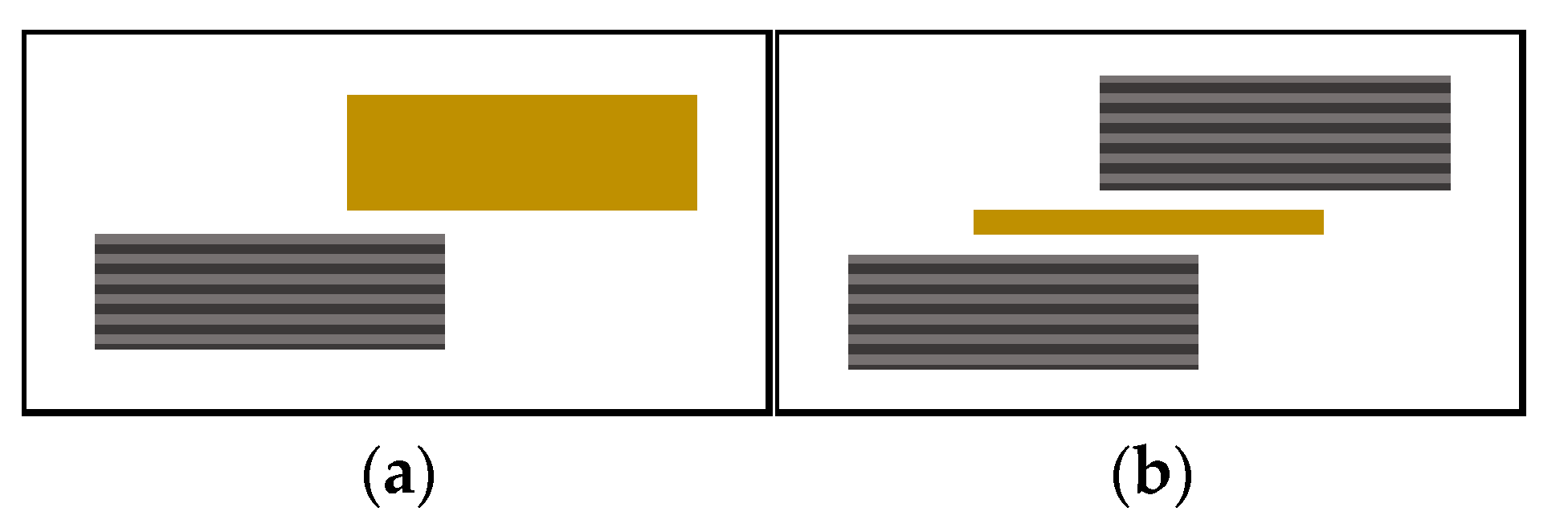
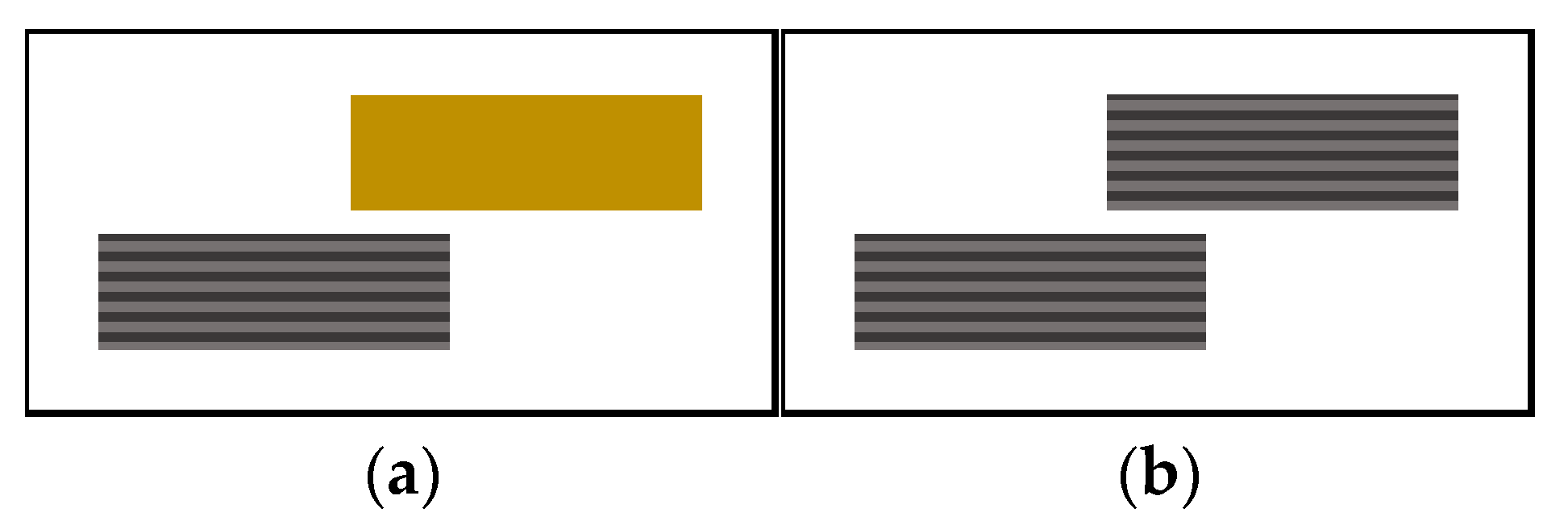

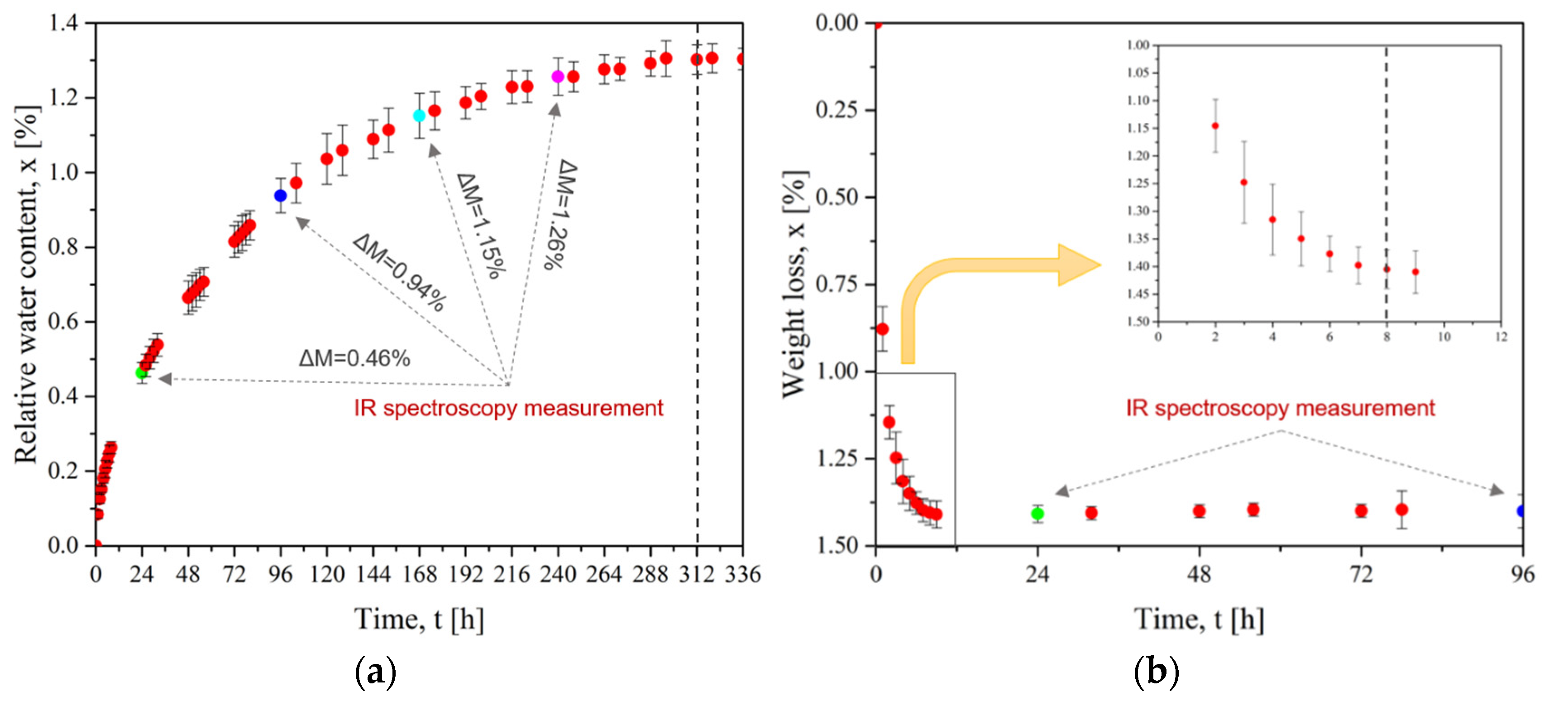
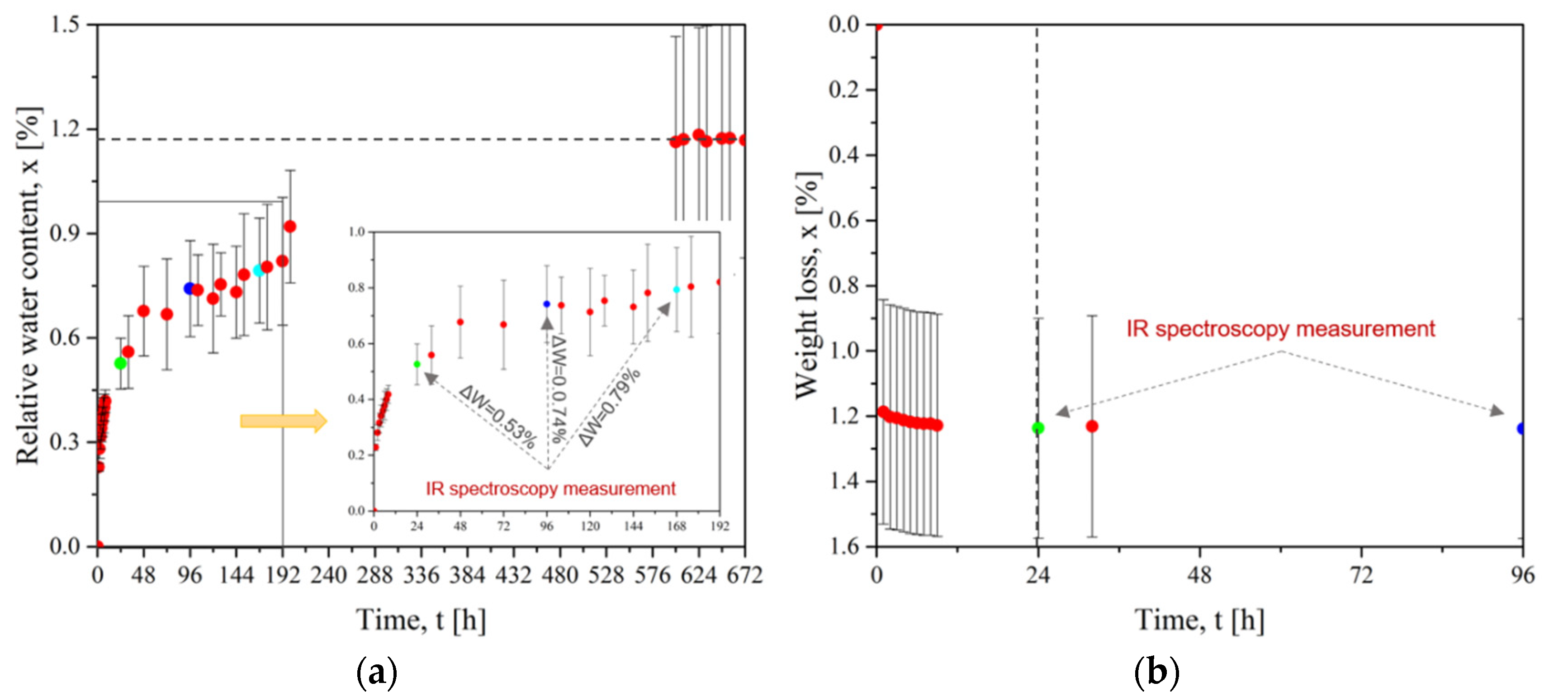
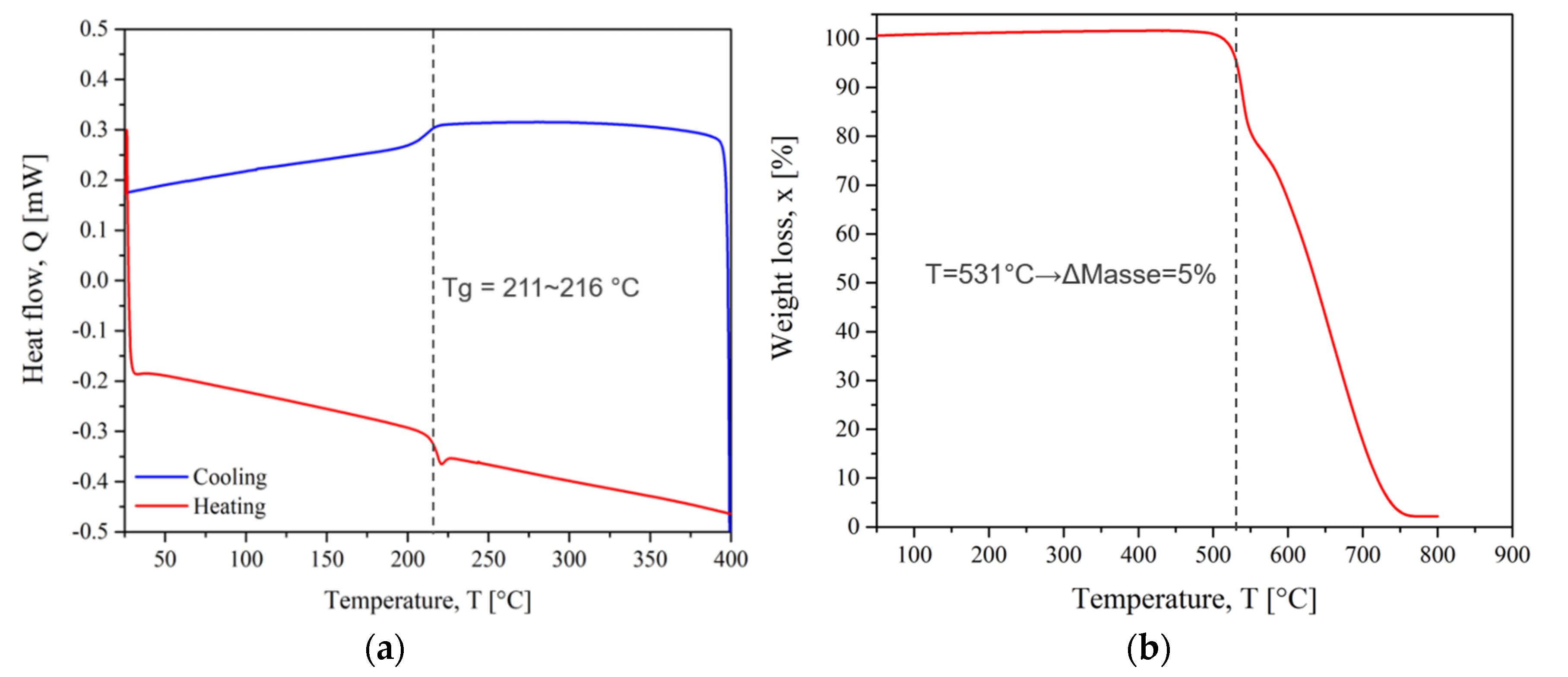
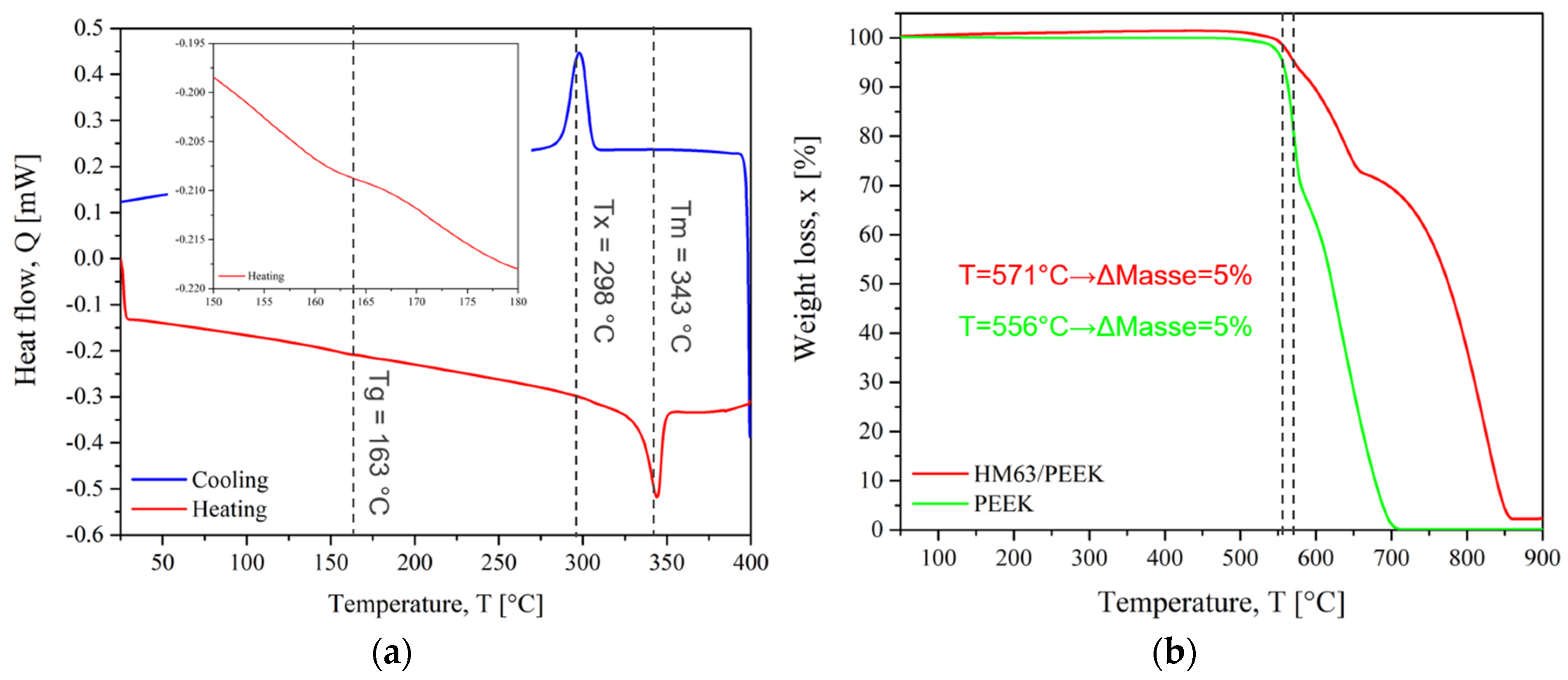

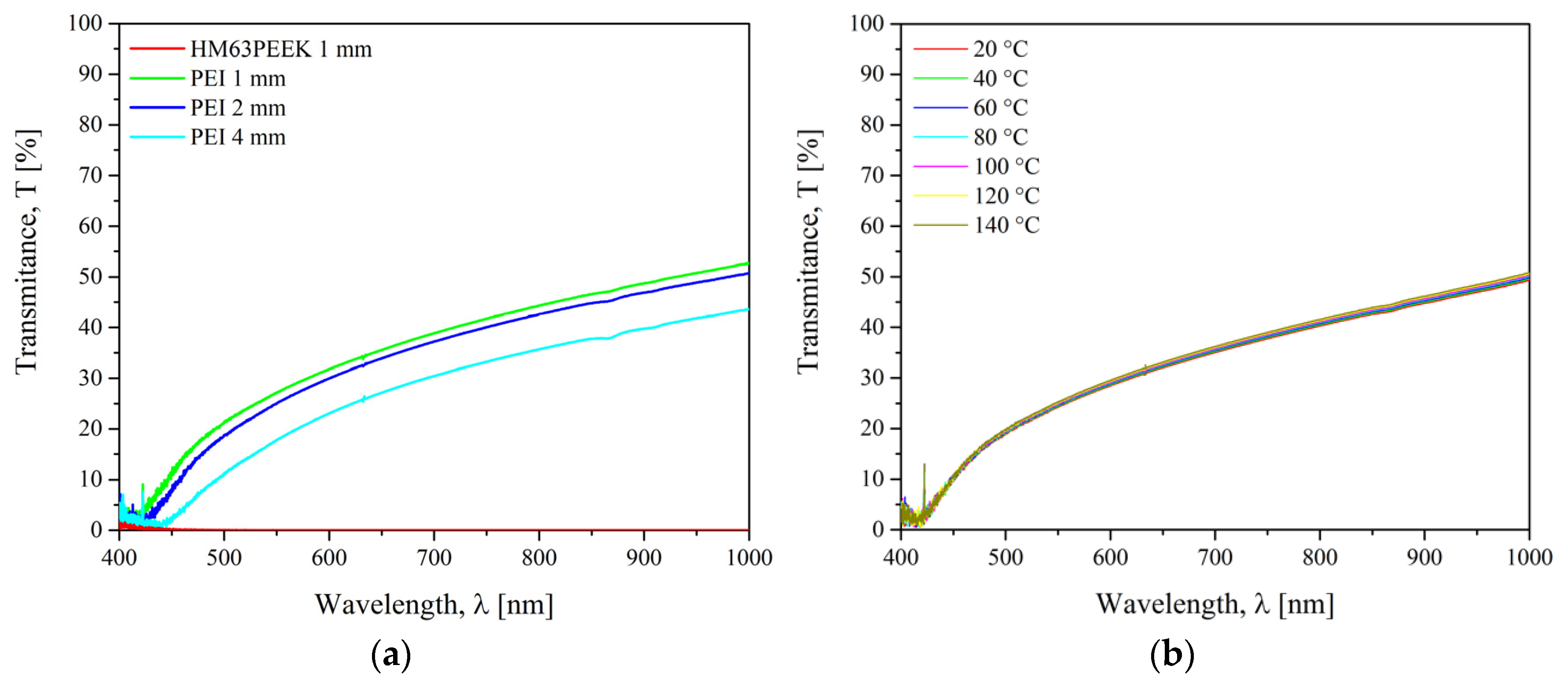
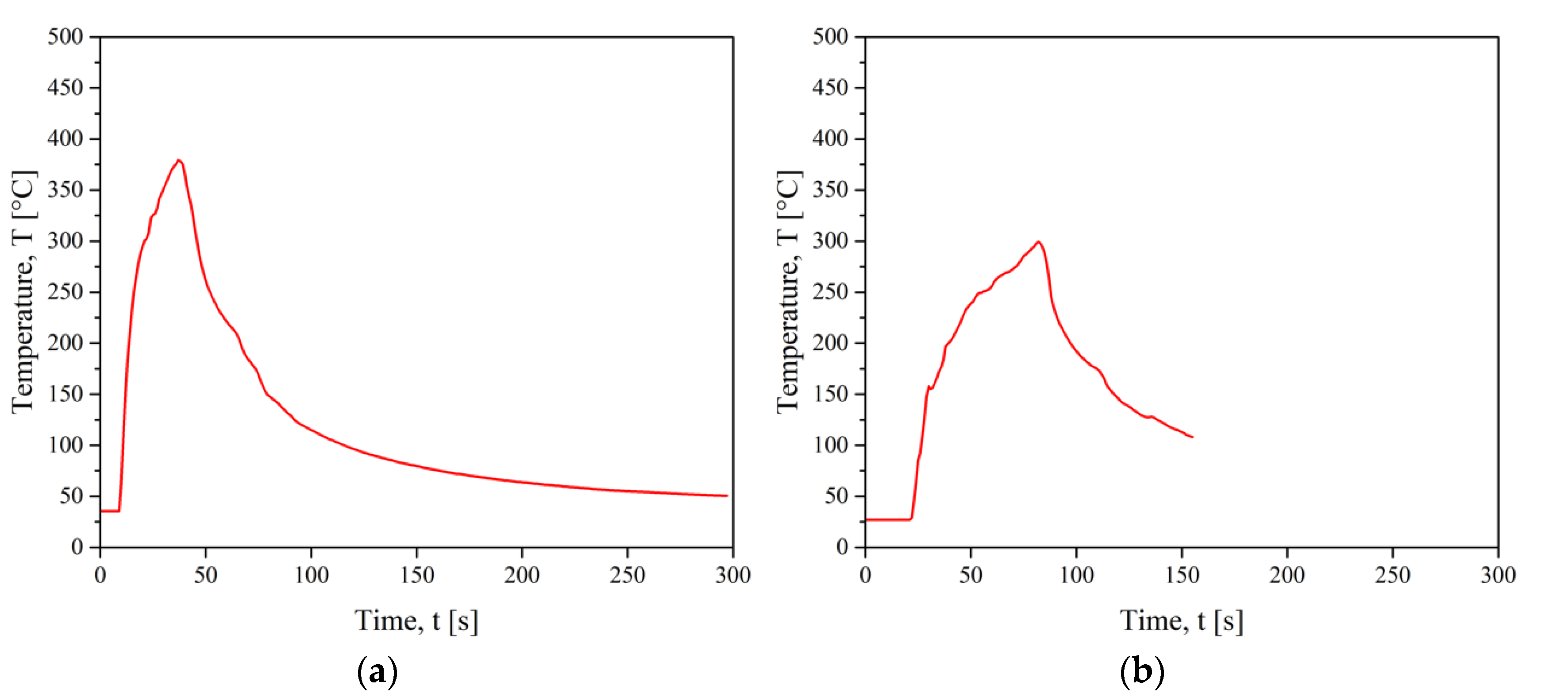
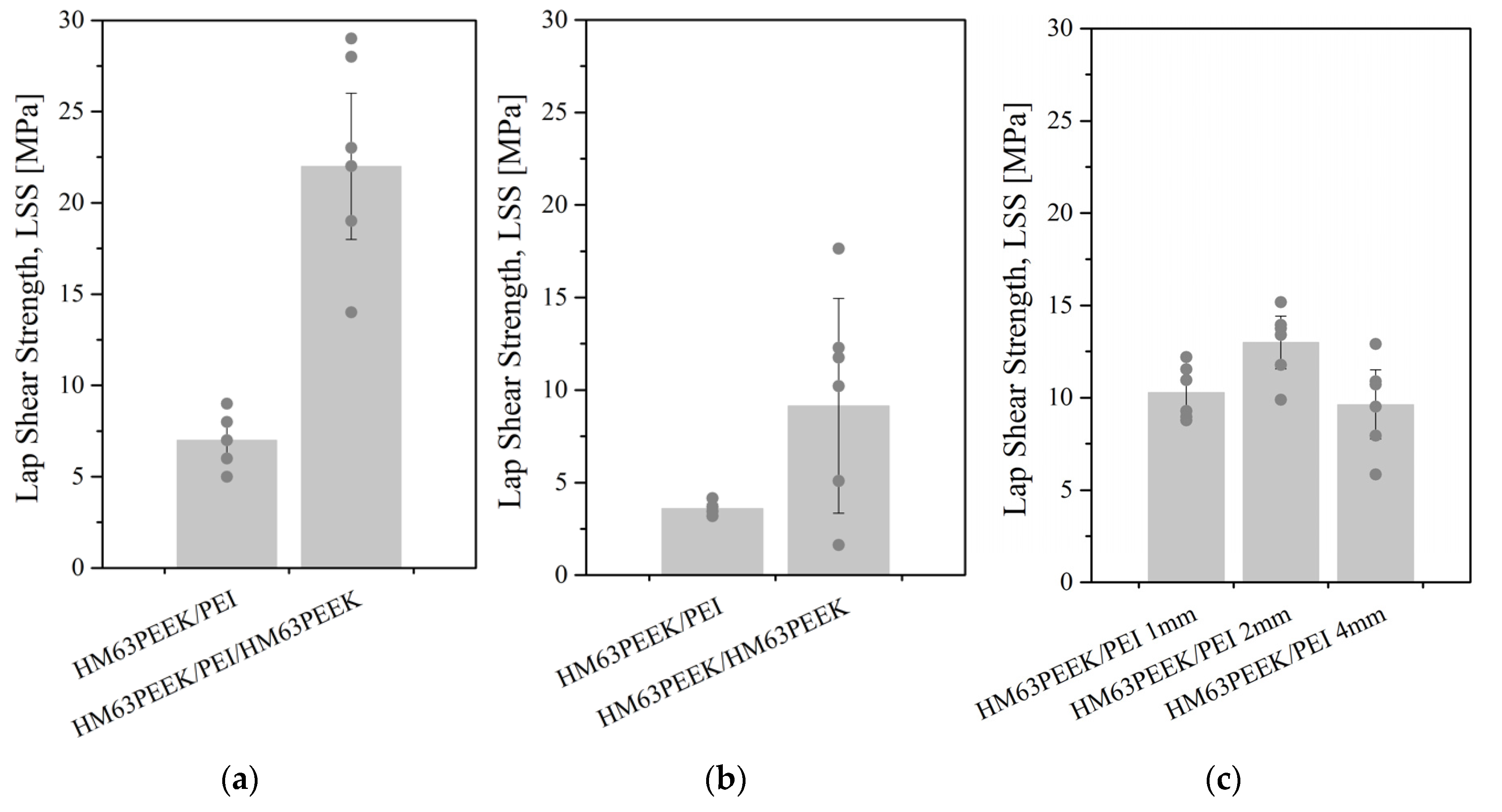
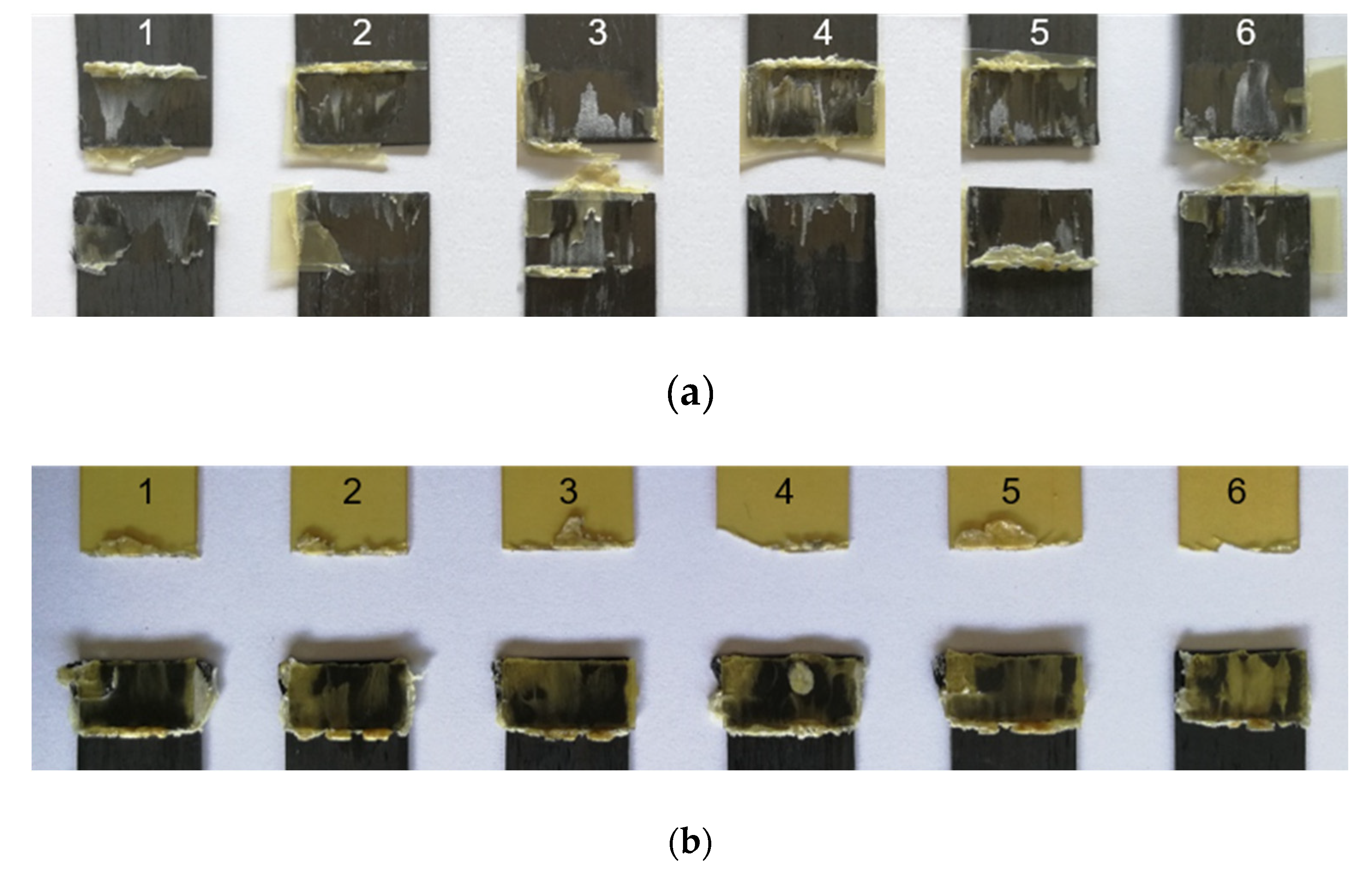

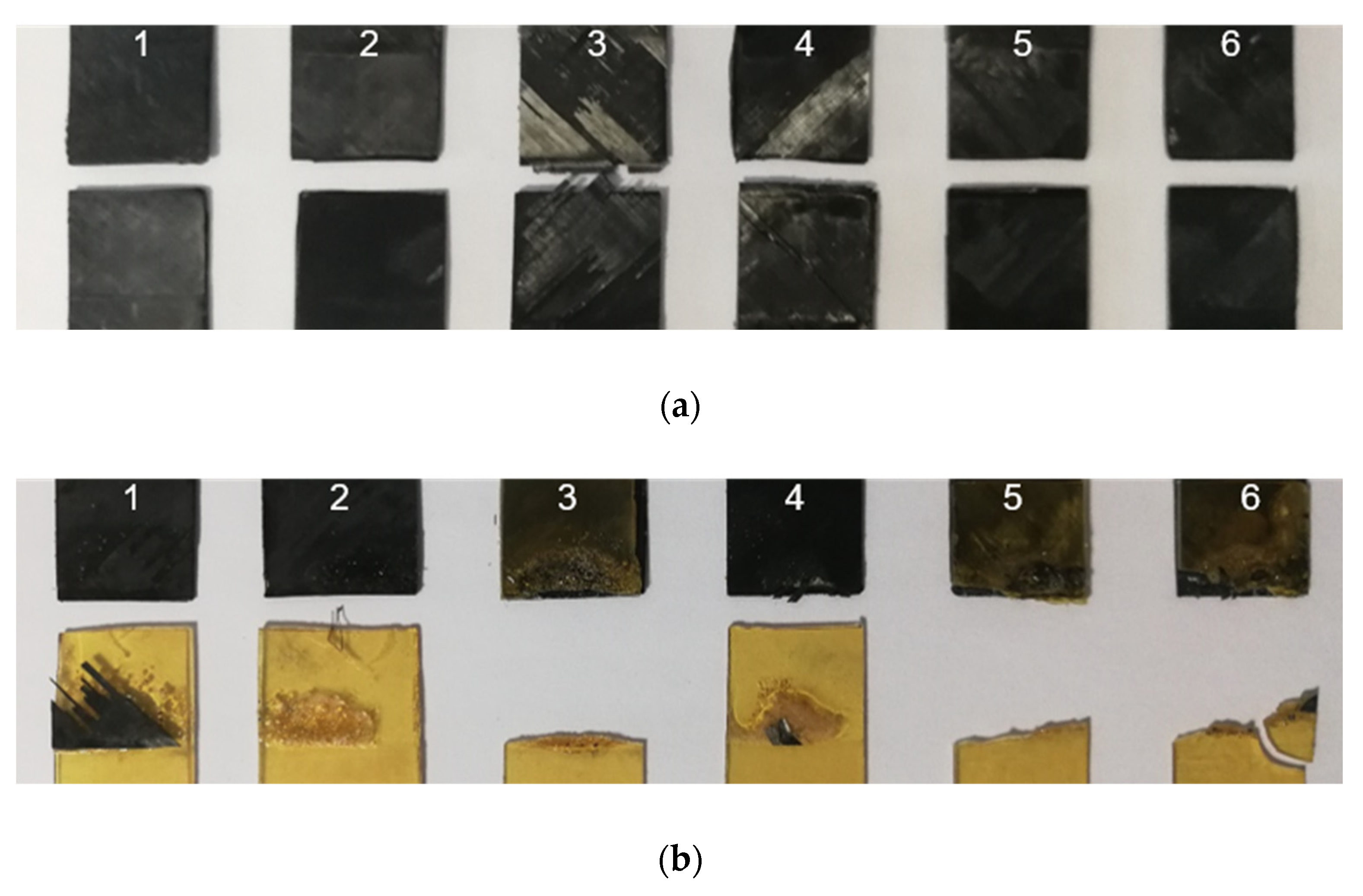

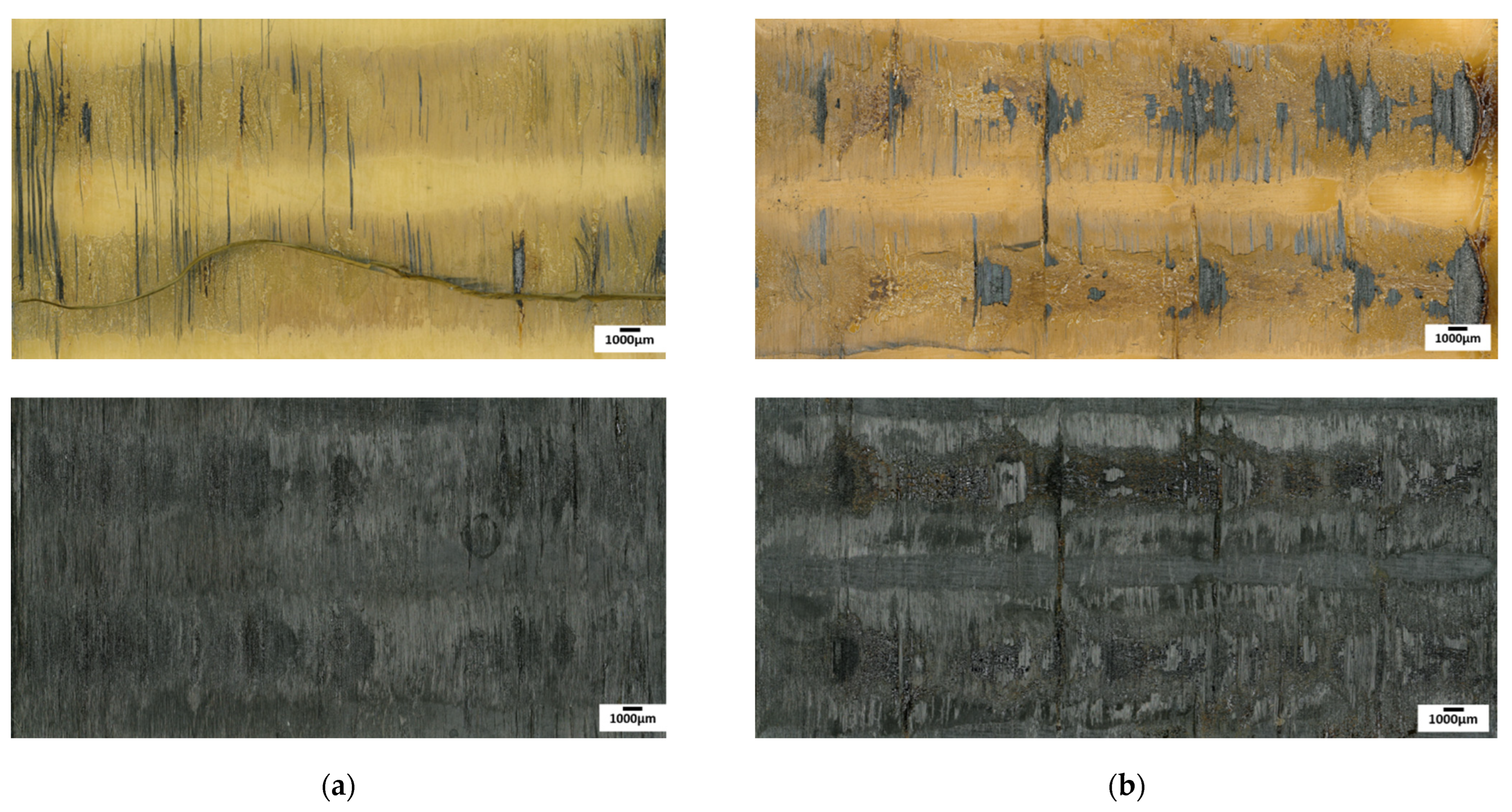
| In K·s−1 | Ultrasonic Welding | Induction Welding | Laser Welding |
|---|---|---|---|
| Heating ramp | 1000 | 10 | 200 |
| Cooling ramp | 500 | 5 | 100 |
Publisher’s Note: MDPI stays neutral with regard to jurisdictional claims in published maps and institutional affiliations. |
© 2022 by the authors. Licensee MDPI, Basel, Switzerland. This article is an open access article distributed under the terms and conditions of the Creative Commons Attribution (CC BY) license (https://creativecommons.org/licenses/by/4.0/).
Share and Cite
Korycki, A.; Garnier, C.; Bonmatin, M.; Laurent, E.; Chabert, F. Assembling of Carbon Fibre/PEEK Composites: Comparison of Ultrasonic, Induction, and Transmission Laser Welding. Materials 2022, 15, 6365. https://doi.org/10.3390/ma15186365
Korycki A, Garnier C, Bonmatin M, Laurent E, Chabert F. Assembling of Carbon Fibre/PEEK Composites: Comparison of Ultrasonic, Induction, and Transmission Laser Welding. Materials. 2022; 15(18):6365. https://doi.org/10.3390/ma15186365
Chicago/Turabian StyleKorycki, Adrian, Christian Garnier, Margot Bonmatin, Elisabeth Laurent, and France Chabert. 2022. "Assembling of Carbon Fibre/PEEK Composites: Comparison of Ultrasonic, Induction, and Transmission Laser Welding" Materials 15, no. 18: 6365. https://doi.org/10.3390/ma15186365
APA StyleKorycki, A., Garnier, C., Bonmatin, M., Laurent, E., & Chabert, F. (2022). Assembling of Carbon Fibre/PEEK Composites: Comparison of Ultrasonic, Induction, and Transmission Laser Welding. Materials, 15(18), 6365. https://doi.org/10.3390/ma15186365








